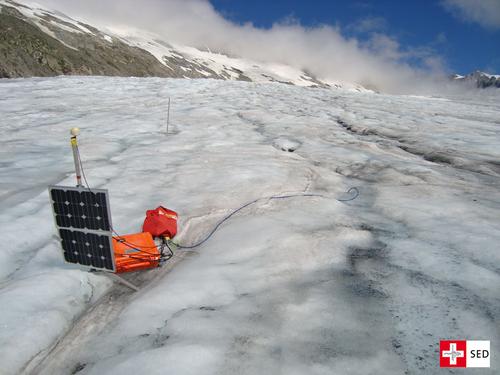2012-09-17
SED Field Campaign on Rhonegletscher in the Swiss Alps
The Swiss Seismological Service is investigating the dynamical behavior of the Rhonegletscher, focussing specifically on changes in the subglacial drainage system. This project is conducted in partnership with two other research teams from ETH. The data collected through multiple measurement techniques help to understand how various factors, climate change and glacier retreat, impact the dynamical behaviour of the glacier.
Read more...Since May 2012, the SED operates three shallow borehole seismometers on the Rhonegletscher, VS. This installation is part of a larger field campaign of the SED, the glaciology group at the VAW (Laboratory of Hydraulics, Hydrology and Glaciology, ETH Zurich), and the EEG (Exploration and Environmental Geophysics) group at the Institute of Geophysics, ETH Zurich to study the dynamical behavior of the Rhonegletscher.
During the main field deployment in September 2012, the glaciologists of the VAW will drill deep boreholes to the glacier bed, while the EEG group will conduct active seismic experiments. The SED will install additional ten seismometers on the surface of the Rhonegletscher. In combination with the already installed shallow borehole seismometer the seismological array will monitor icequake activity on the Rhonegletscher. Icequakes are seismic sources within a glacier, which occur due to opening and closure of crevasses, movement of fluids (hydrofracturing), and coupling of the glacier to his bed.
By locating and studying icequake source mechanisms, including their temporal and spatial evolution, important insights into the flow dynamics of the Rhonegletscher can be gained. In combination with data acquired by the VAW group and the EEG group a unique data set of different measurements on the Rhonegletscher will be acquired. This data set will help to improve our understanding of an Alpine glacier’s dynamical behavior in relation to changes in the subglacial drainage system caused by climate change and glacier retreat, also affecting the Swiss Alps.
